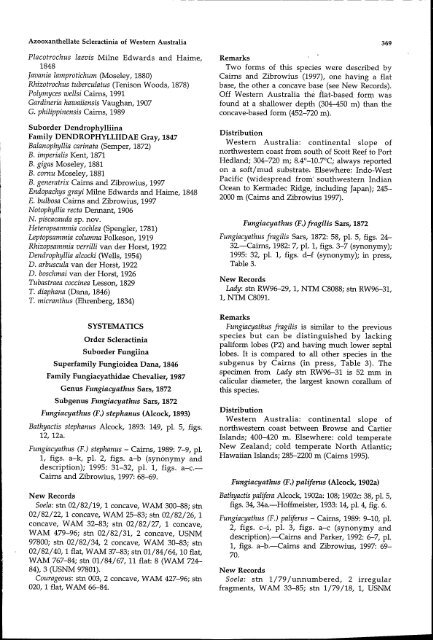Azooxanthellate Scleractinia (Cnidaria: Anthozoa) - Western ...
Azooxanthellate Scleractinia (Cnidaria: Anthozoa) - Western ...
Azooxanthellate Scleractinia (Cnidaria: Anthozoa) - Western ...
You also want an ePaper? Increase the reach of your titles
YUMPU automatically turns print PDFs into web optimized ePapers that Google loves.
<strong>Azooxanthellate</strong> <strong>Scleractinia</strong> of <strong>Western</strong> Australia<br />
Placotrochus laevis Milne Edwards and Haime,<br />
1848<br />
Javania lamprotichum (Moseley, 1880)<br />
Rhizotrochus tuberculatus (Tenison Woods, 1878)<br />
Polymyces wellsi Cairns, 1991<br />
Gardineria hawaiiensis Vaughan, 1907<br />
G. philippinensis Cairns, 1989<br />
Suborder Dendrophylliina<br />
Family DENDROPHYLLIIDAE Gray, 1847<br />
Balanophyllia carinata (Semper, 1872)<br />
B. imperialis Kent, 1871<br />
B. gigas Moseley, 1881<br />
B. cornu Moseley, 1881<br />
B. generatrix Cairns and Zibrowius, 1997<br />
Endopachys grayi Milne Edwards and Haime, 1848<br />
E. bulbosa Cairns and Zibrowius, 1997<br />
Notophyllia recta Dennant, 1906<br />
N. piscacauda sp. novo<br />
Heteropsammia cochlea (Spengler, 1781)<br />
Leptopsammia columna Folkeson, 1919<br />
Rhizopsammia verrilli van der Horst, 1922<br />
Dendrophyllia alcocki (Wells, 1954)<br />
D. arbuscula van der Horst, 1922<br />
D. boschmai van der Horst, 1926<br />
Tubastraea coccinea Lesson, 1829<br />
T. diaphana (Dana, 1846)<br />
T. micranthus (Ehrenberg, 1834)<br />
SYSTEMATICS<br />
Order <strong>Scleractinia</strong><br />
Suborder Fungiina<br />
Superfamily Fungioidea Dana, 1846<br />
Family Fungiacyathidae Chevalier, 1987<br />
Genus Fungiacyathus Sars, 1872<br />
Subgenus Fungiacyathus Sars, 1872<br />
Fungiacyathus (F.) stephanus (Alcock, 1893)<br />
Bathyactis stephanus Alcock, 1893: 149, pI. 5, figs.<br />
12, 12a.<br />
Fungiacyathus (F.) stephanus - Cairns, 1989: 7-9, pI.<br />
1, figs. a-k, pI. 2, figs. a-b (synonymy and<br />
description); 1995: 31-32, pI. 1, figs. a-c.<br />
Cairns and Zibrowius, 1997: 68-69.<br />
New Records<br />
Soela: stn 02/82/19, 1 concave, WAM 300-88; stn<br />
02/82/22, 1 concave, WAM 25-83; stn 02/82/26, 1<br />
concave, WAM 32-83; stn 02/82/27, 1 concave,<br />
WAM 479-96; stn 02/82/31, 2 concave, USNM<br />
97800; stn 02/82/34, 2 concave, WAM 30-83; stn<br />
02/82/40, 1 flat, WAM 37-83; stn 01/84/64, 10 flat,<br />
WAM 767-84; stn 01/84/67, 11 flat: 8 (WAM 724<br />
84), 3 (USNM 97801).<br />
Courageous: stn 003, 2 concave, WAM 427-96; stn<br />
020, 1 flat, WAM 66-84.<br />
--------------- - --<br />
369<br />
Remarks<br />
Two forms of this species were described by<br />
Cairns and Zibrowius (1997), one having a flat<br />
base, the other a concave base (see New Records).<br />
Off <strong>Western</strong> Australia the fIat-based form was<br />
found at a shallower depth (304-450 m) than the<br />
concave-based form (452-720 m).<br />
Distribution<br />
<strong>Western</strong> Australia: continental slope of<br />
northwestern coast from south of Scott Reef to Port<br />
Hedland; 304-720 m; 8.4°-1O.7°C; always reported<br />
on a soft/mud substrate. Elsewhere: Indo-West<br />
Pacific (widespread from' southwestern Indian<br />
Ocean to Kermadec Ridge, including Japan); 245<br />
2000 m (Cairns and Zibrowius 1997).<br />
Fungiacyathus (F.) fragilis San., 1872<br />
Fungiacyathus fragilis Sars, 1872: 58, pI. 5, figs. 24<br />
32.-Cairns, 1982: 7, pI. 1, figs. 3-7 (synonymy);<br />
1995: 32, pI. 1, figs. d-f (synonymy); in press,<br />
Table 3.<br />
New Records<br />
Lady: stn RW96-29, 1, NTM C8088; stn RW96-31,<br />
1, NTM C8091.<br />
Remarks<br />
Fungiacyathus fragilis is similar to the previous<br />
species but can be distinguished by lacking<br />
paliform lobes (P2) and having much lower septal<br />
lobes. It is compared to all other species in the<br />
subgenus by Cairns (in press, Table 3). The<br />
specimen from Lady stn RW96-31 is 52 mm in<br />
calicular diameter, the largest known corallum of<br />
this species.<br />
Distribution<br />
<strong>Western</strong> Australia: continental slope of<br />
northwestern coast between Browse and Cartier<br />
Islands; 400-420 m. Elsewhere: cold temperate<br />
New Zealand; cold temperate North Atlantic;<br />
Hawaiian Islands; 285-2200 m (Cairns 1995).<br />
Fungiacyathus (F.) paliferus (Alcock, 1902a)<br />
Bathyactis palifera Alcock, 1902a: 108; 1902c: 38, pI. 5,<br />
figs. 34, 34a.-Hoffmeister, 1933: 14, pI. 4, fig. 6.<br />
Fungiacyathus (F.) paliferus - Cairns, 1989: 9-10, pI.<br />
2, figs. c-i, pI. 3, figs. a-c (synonymy and<br />
description).-Cairns and Parker, 1992: 6-7, pI.<br />
1, figs. a-b.-Cairns and Zibrowius, 1997: 69<br />
70.<br />
New Records<br />
Soela: stn 1/79/unnumbered, 2 irregular<br />
fragments, WAM 33-85; stn 1/79/18, 1, USNM
















